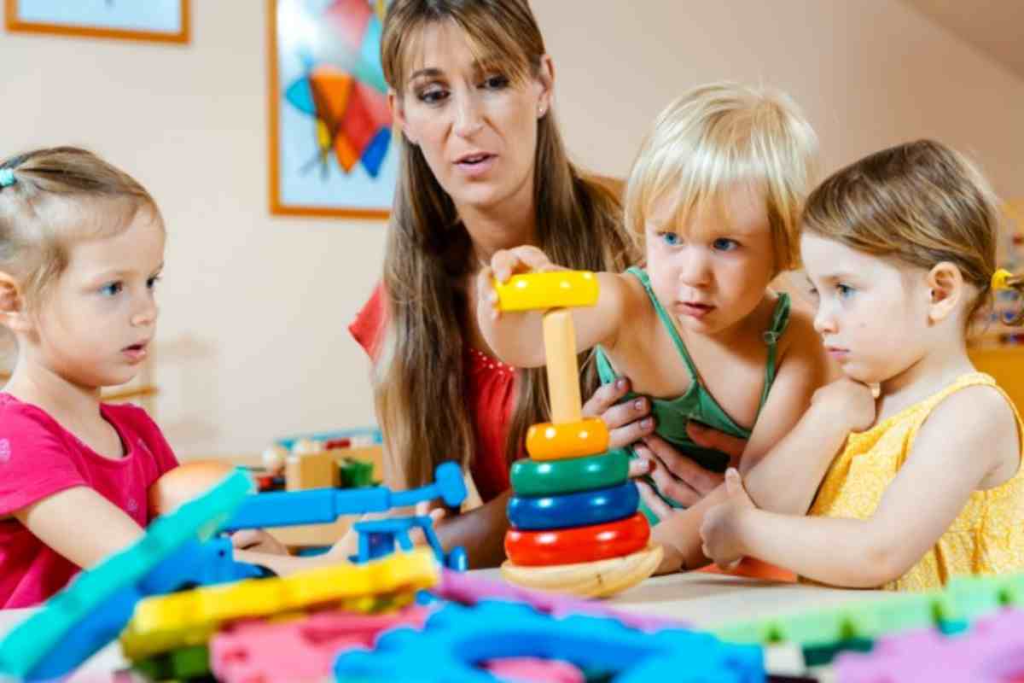Last Updated on November 14, 2025 by

Developmental stages are key in early life Children. They set the stage for health, learning, and well-being. The four main types are physical, cognitive, language, and social-emotional development. Each one is important for shaping who we are and what we can do.
It’s important for parents, caregivers, and professionals to understand these stages. This includes those with the CDA Council or trained by Service Master. They can then offer the right support and help where needed.
It’s key for parents and caregivers to understand child development. This knowledge lets them supervise and help their child grow. They can spot any problems early.
Knowing the different stages of child development is important. It helps caregivers give the right support. This way, children get the help they need when they need it, helping them grow well.
Children grow at their own pace. Things like genetics, environment, and resources can affect this. Caregivers need to understand these differences. They should know when to supervise closely and when to give freedom.
Important things to think about include:

Physical development is key in a child’s early years. It covers both big and small muscle skills. These skills help a child move and interact with their world.
Gross motor skills use big muscles for actions like crawling, walking, and running. These skills are vital for a child’s movement and balance. For example, crawling is a major milestone in the first year.
Fine motor skills use small muscles for actions like holding things and drawing. Teacher assistants can help improve these skills with activities. Puzzles and playdough, for instance, can boost fine motor skills, preparing kids for writing.
Helping with physical development is a team effort. Parents, teachers, and even teacher assistant jobs can play a part. By knowing the milestones and providing the right support, we can help kids reach their physical development goals.

The cognitive development phase is key. It includes better memory, problem-solving, and understanding the world. Early childhood sees big leaps in these areas, setting the stage for future thinking skills.
Children start to remember past events and learn from them. This is important for problem-solving skills. For example, a child might use a learned method to solve a puzzle, showing growth in thinking.
Some key aspects of cognitive development include:
As children grow, they get better at understanding their world. They learn to move around, grasp spatial relationships, and interact with things and people. This skill is essential for their thinking and is seen in their ability to master programming or complete work units.
Cognitive development is a complex process. It’s shaped by both genes and the environment. Knowing this helps create supportive spaces for healthy brain growth.
Between 1 and 5 years old, kids grow their language skills fast. By age 5, they can know over 2,000 words, says the CDC. This time is key for building strong communication skills.
Kids start with simple words and then learn complex sentences. Early help and a caring home are very important. Parents can help by talking, reading, and encouraging kids to share their thoughts.
As kids learn more words, they get better at talking. They can tell us what they need, want, and feel. Good talking skills help kids grow socially and emotionally. Teachers with course definition and council for professional recognition can offer great advice and methods for language growth.
The fourth type of child development is social-emotional. It’s about how kids learn to know themselves and get along with others. This is key because it shapes how they see themselves and how they interact with the world.
Self-awareness is a big part of social-emotional growth. It means kids can spot their feelings, know their good and bad points, and figure out who they are. Knowing themselves well helps build confidence and self-worth. As they grow, kids start to find out who they are by trying new things and seeing what they care about. This helps them understand their place in the world.
Learning to make friends is also a big part of growing up. Kids start to get better at feeling for others and working together around age 3. Good friendships are based on trust, talking openly, and respect for each other. By learning these skills, kids can make strong, lasting friendships as they get older.
Just like a cd holder keeps CDs tidy, social-emotional growth helps kids sort out their feelings and actions. This leads to better relationships with others.
Developmental disabilities can greatly affect a child’s growth, showing why early help is vital. Studies reveal that 1 in 6 kids in the U.S. aged 3“17 face these challenges. This underlines the need for awareness and support.
The number of kids with developmental disabilities is rising. This makes the role of a teacher assistant even more important. They provide support that meets each child’s unique needs.
Early intervention is essential for kids with developmental disabilities. It involves spotting at-risk children and giving them focused support. This way, their development can improve. The goal is to create a supportive space that encourages growth.
By tackling developmental disabilities, we can help kids overcome hurdles. This way, they can reach their highest possible level of achievement.
Children need support in four key areas: physical, cognitive, language, and social-emotional. Places like Liv Hospital use international standards and team efforts to help. This ensures kids grow well.
Parents can make homes rich with activities for kids. A meet the teacher template helps kids talk well with teachers. This creates a great place to learn.
Play is key for kids’ growth. It boosts thinking skills, keeps them active, and helps with feelings. Puzzles, blocks, and acting out roles are very important.
If you worry about your child’s growth, get help early. Early action can really help a child’s development.
Understanding the four types of child development is key. These include physical, cognitive, language, and social-emotional. Knowing these areas helps parents and caregivers create great environments for kids to grow.
Spotting delays or disabilities early is vital. It lets us act fast to help a child reach their best. This early action can make a big difference in a child’s life.
Knowing about child development helps us support kids in specific ways. This ensures they get the care they need to do well. It’s all about helping kids be their best and succeed in the future.
A Teacher Assistant helps children grow by working with a qualified teacher. They give each child special attention and help them reach their goals.
Parents can help their child grow at home by making learning fun. They can play and learn together. This way, they can see how their child is doing and get help when needed.
The CDA Council helps early childhood education by giving teachers the skills they need. They make sure teachers know how to help young children learn and grow.
Work units are tasks that help children learn and grow. They help teachers see how well children are doing and what they need to learn more.
A Service Master keeps places where children learn safe and ready. They make sure everything works well so children can focus on learning.
Child development programs focus on all parts of a child’s growth. They work on physical, cognitive, language, and social-emotional skills. This helps children grow well-rounded and happy.
A Meet the Teacher template helps parents meet their child’s teacher. It’s a chance to talk about what their child needs and how they can help. It builds a team effort for their child’s growth.
Master Programming is top-notch education for children. It meets their needs and helps them succeed in the future. It’s all about giving children the best start in life.
A CD Holder is someone who knows a lot about helping young children grow. They have a special credential that shows they’re experts in child development.
These units help children grow by providing a supportive place to learn. They help children learn and grow in all important areas.
The course definition is the plan for teaching children. It outlines what children will learn and how they will grow. It’s the roadmap for their education.
Teacher Assistants work with teachers to help children learn. They give each child special help and support. This helps children reach their goals and grow.
The Six are the main skills that teachers need to help children grow. They are important for supporting young children’s development, as set by the CDA Council.
Subscribe to our e-newsletter to stay informed about the latest innovations in the world of health and exclusive offers!